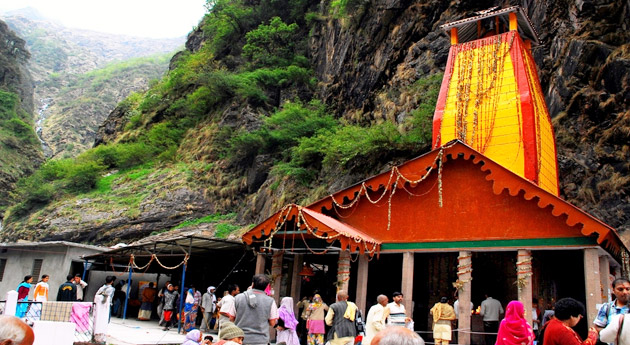Kedarnath Dham

Kedarnath Dham, located in the Rudraprayag district of Uttarakhand, is one of the most paramount locations for worshipers of Shiva. The air appears to be reverberating with the name of Lord Shiva amid the mighty snow-clad peaks, enchanting meadows and forests of the lower mountain range of Himalayas. Situated in a breathtaking location, near the source of Mandakini River and at the height of 3,584 meters, Kedarnath Dham celebrates the greatness of Lord Shiva. Kedarnath temple is one of the 12 Jyotir Lingams and is also the most important temple among the Panch Kedars (group of 5 Shiva temples in Garhwal Himalayas). It is also one of the significant temples of the sacred Chota Char Dham Yatra in Uttarakhand, raising the glory of the place to further heights.
Accessible from major destinations of Uttarakhand, the motorable road towards Kedarnath temple stretches till Gauri Kund. After that one needs to take a 14 km trek towards Kedarnath temple. Ponies and palanquins (doli) are easily available; one can also avail helicopter services during peak season of yatra.
The hard journey till the great shrine of Shiva is well compensated with the spiritual atmosphere which is created by the unruffled, tranquil and splendid beauty of the region. The majestic Kedarnath peak (6,940 meters) stands behind the temple along with other peaks, forming a perfect setting for the holy land of the supreme deity. The conical-shaped Shiva lingam in the Kedarnath temple is a unique feature of the temple among all Shiva shrines.
Burdened with the guilt of killing their blood relatives, Pandavas sought Lord Shiva to absolve themselves of their sins. Shiva didn't want to release them from their wrongdoings so easily and disguised himself as a bull to roam in Garhwal Himalayas. On being discovered by Pandavas, Shiva dived into the ground. Bhim tried to catch him and could only get hold of the hump. Other body parts of Shiva (in the form of bull), came up at different places. Hump of the bull was found in Kedarnath, navel emerged at Madhya-Maheshwar, two forelegs appeared at Tunganath, face in Rudranath, and hair came up at Kalpeshwar. Together these five sacred places are called Panch Kedar. It is believed that originally Pandavas built the temple of Kedarnath; the present temple was established by Adi Shankaracharya who restored and revived the glory of the shrine.
Badrinath Dham

The picturesque town of Badrinath is where divinity meets with the serenity of nature. Located in the Chamoli district in Uttarakhand at the height of 3,133 meters, the pre-eminent abode of Lord Vishnu is one of the holiest of the holy shrines of Char Dham pilgrimage in India. Other Char Dham sites include Dwarka, Puri and Rameswaram.
Situated between Nar and Narayan peaks, the pious land of Vishnu also belongs to the Chota Char Dham Yatra in Uttarakhand. Starting with Yamunotri, Gangotri and Kedarnath, Badrinath is the last and most celebrated stop in the pilgrimage tour of Garhwal Himalayas. Badrinath Dham is easily accessible by motorable roads and the Badrinath temple can be reached by walking along an easy trek. Around 3 km from Badrinath is the village of Mana, which is one of the last villages before the boundary of India ends and that of Tibet begins. The peak of Neelkanth stands strong spreading its mighty aura for all pilgrims and travellers alike.
Badrinath is a land of myriad legends, each one only adding to the glory of this place. Along with these legends, the snowy mountain peaks, gracefully flowing Alaknanda River and incredible landscapes create the perfect background to facilitate a spiritual connection.
Badrinath being one of the most legendary Temples, it has numerous mythical tales associated with it. According to one mythological tale, Lord Vishnu had performed rigorous atonement at this place. During his intense meditation, he was unaware about the severe weather conditions. To protect him from the scorching heat of the sun, his spouse Goddess Lakshmi acquired the shape of Badri tree and spread over him. Witnessing this, Lord Vishnu was pleased by her devotion and hence he named the spot after her as Badrikashram.
Another legend states that, Lord Shiva and Goddess Parvati were once performing tapasya in Badrinath. It was then Lord Vishnu came in disguise as a small boy and disrupted them, by crying loudly. On hearing that Goddesses Parvati asked him the reason behind his mournful behavior, to which he replied that he wanted to meditate in Badrinath. Shiva and Parvati, on discovering Lord Narayan in disguise, left Badrinath and moved to Kedarnath.
Badrinath Dham is also related to the tale of the two sons of Dharma, Nar and Narayana who wished to setup their hermitage and expand their religious base amidst the pious Himalayas. Going by the legends, during their quest to find a suitable place for their hermitage they led to a chanced discovery of the four sites of Panch Badri, namely Dhyan Badri, Yog Badri , Bridha Badri and Bhavishya Badri. Finally they came across a spot which was blessed with two fascinating cold and hot springs behind river Alaknanda. They were extremely overjoyed on finding this place and thus they named this place as Badri Vishal, this is how Badrinath came into being.
Badrinath Dham Tourist Spot Are:
Barhma Kapal
It is a flat platform by the banks of Alaknanda 100 meters north of the temple. Performing propitiating rites for the deceased family members, it is believed, would free them from the vicious circle of life and death.
Neelkanth Peak
Known as the 'Queen of Garhwal', Neelkanth Peak, standing with its gigantic height of 6,597 meter (approx.), sets a great background to the Badrinath shrine. Named after Lord Shiva, the splendour of the snow-covered peak gets augmented as it receives the first rays of the Sun at the crack of dawn.
Mata Murti Mandir
It is located 3 km from the Badrinath temple, on the banks of Alaknanda River. Mata Murti temple is believed to be the mother of Nara and Narayan, the twin-brother avatar (incarnation) of Lord Vishnu. It was the relentless prayers of Mata Murti that persuaded Lord Vishnu to take birth from her womb. Every year, in the month of September, pilgrims throng to attend the Mata Murti ka Mela (fair).
Charanpaduka
Strewn with boulders and caves, a steep climb of about 3 km from the Badrinath town will take you to Charanpaduka. It is a rock which is believed to be imprinted with the footprints of Lord Vishnu, as he descended on earth from Vaikunth (his heavenly abode).
Sheshnetra
Between two seasonal lakes, on the opposite bank of Alaknanda, there exists a big rock which gives the impression of Shesh Nag, the legendary snake of Lord Vishnu. The Sheshnetra has a natural mark which looks like an eye of the Shesh Nag. Located 1.5 km from the temple, the serpent is believed to be guarding the sacred shrine of Badrinath.
Vasudhara Falls
A 122 meters high beautiful waterfall positioned in the tranquil surroundings of Himalayas can be reached by covering 3 km (up to Mana village) by road and trekking the other 6 km on foot.
Gangotri - The Abode of Goddess Ganga

Gangotri (Hindi: गंगोत्री) is a town and a Nagar Panchayat (municipality) in Uttarkashi district in the state of Uttarakhand, India. It is a Hindu pilgrim town on the banks of the river Bhagirathi and origin of River Ganges. It is on the Greater Himalayan Range, at a height of 3,100 metres (10,200 ft). According to popular Hindu legend, it was here that Goddess Ganga descended when Lord Shiva released the mighty river from the locks of his hair. Gangotri is the highest and the most important temple of River Ganga. According to Hindu Mythology, Gangotri is the place where river Ganga descended from the heaven when Lord Shiva released the mightly river from his luscious locks.
Gangotri, the origin of the River Ganges and seat of the goddess Ganga, is one of the four sites in the Chota Char Dham pilgrimage circuit. The original Gangotri Temple was built by the Nepalese general Amar Singh Thapa. The river is called Bhagirathi at the source and acquires the name Ganga (the Ganges) from Devprayag onwards where it meets the Alaknanda. The origin of the holy river is at Gaumukh, set in the Gangotri Glacier, and is a 19 km trek from Gangotri.Gangotri is a small town centered around the temple of Gangotri temple and is one of the holy places among the four Char Dhams. It is cuddled in the heart of Uttarkashi district of Uttarakhand and is located close to the Indo-Tibetan border. It is the highest and the most important temple of river Ganga which is worshiped as a Goddess in India.
Places to visit near the Gangotri Temple
Bhagirath Shila
Bhagirath Shila is believed to be the holy rock where King Bhagirath prayed to Lord Shiva.
Pandava Gufa
Pandava Gufa, located 1.5 km from Gangotri, is the place where the Pandavas are believed to have meditated and rested en route Kailash. Pilgrims will have to trek up to the Pandava Gufa.
In the pilgrimage journey of Chota Char Dham, Gangotri is often visited after Yamunotri (located on the western region of Garhwal Hills). Pilgrims generally make Uttarkashi as their base camp. The time taken from Uttarkashi to Gangotri temple is about 4 hours by road.
Comments
No posts found
































